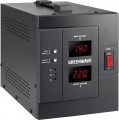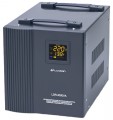Input voltage range
The voltage range at the input of the stabilizer, at which it is able to operate in normal mode and supply a constant voltage of 230 or 400 V to the load (depending on the number of phases, see above). The wider this range — the more versatile the device, the more serious power surges it can extinguish without going beyond the standard operating parameters. However, note that this parameter is not the only, and not even far from the main indicator of the quality of work: a lot also depends on the accuracy of the output voltage and the response speed (see both points below).
Also note that some models may have several modes of operation (for example, with 230 V, 230 V or 240 V output). In this case, the characteristics indicate the "general" input voltage range, from the smallest minimum to the largest maximum; the actual ranges for each particular mode will vary.
In addition, there are stabilizers that can operate outside the nominal input voltage range: with a slight deviation beyond its limits, the device provides relatively safe output indicators (also with some deviations from the nominal 230 or 400 V), but if the drop or rise becomes critical, it works appropriate protection (see below).
Output voltage accuracy (±)
The largest deviation from the nominal output voltage (230 V or 400 V, depending on the number of phases), which the regulator allows when operating in the normal input voltage range (see above). The smaller this deviation, the more efficiently the device works, the more accurately it adapts to “changes in the situation” and the less voltage fluctuations the connected load is exposed to.
When choosing for this parameter, it is worth considering first of all how demanding the connected devices are for voltage stability. On the one hand, high stability is good for any device, on the other hand, it usually means a high price. Accordingly, it usually does not make sense to buy an advanced stabilizer for an unpretentious load like light bulbs and heaters, but for sensitive devices like audio systems or computers, it can be very useful.
Response time
The rate at which the regulator responds to changes in input voltage. It is determined by the time that passes from the moment of a power surge until the moment when the device fully adjusts to the new parameters and the output current corresponds to the standard 230 or 400 V (depending on the number of phases, see above). Accordingly, the shorter the response time, the better the stabilizer works, the lower the likelihood that a power surge will significantly affect the connected equipment. On the other hand, not all types of electrical appliances are sensitive to speed — for some, smooth adjustment or voltage accuracy is more important (see above); and the high speed itself can significantly affect the price of the device. Therefore, when choosing by this parameter, it makes sense to consider which devices are planned to be connected through the stabilizer.
Efficiency
The efficiency of the stabilizer is the ratio, expressed as a percentage, between the amount of electricity at the output of the device to the amount of energy at the input. In other words, efficiency describes how much of the energy received from the network the device transfers to the connected load without loss. And losses during operation will be inevitable — firstly, not a single transformer is perfect, and secondly, the control circuits of the stabilizer also require a certain amount of energy to work. At the same time, all these costs are quite small, and even in relatively simple modern models, the efficiency can reach 97-98%.
Grounded sockets
The number of
sockets for 230 V with grounding provided in the design of the stabilizer.
Some electrical appliances, such as refrigerators and washing/dishwashers, must be grounded when connected. This point should not be ignored — there is a risk of a serious electric shock. Accordingly, the number of sockets with grounding corresponds to the maximum number of such devices that can be simultaneously connected to the stabilizer without the use of splitters. At the same time, ungrounded devices can also be connected to such sockets.
Terminal connection
The presence in the design of the stabilizer of at least two pairs of terminals — at the input and at the output. Unlike sockets, which are designed for frequent connections and disconnections, the
terminal connection is designed to permanently secure the wires — roughly speaking, "attached — clamped — forgot." It does not involve direct connection of electrical appliances, usually the power from the terminals goes further into the mains and is already distributed through it to individual sockets in the room. Accordingly, this option is typical for powerful models (on average from 3 kVA and above, see "Power"), which are designed for installation in one place as a permanent element of the power grid. Often such stabilizers do not have their own outlets at all — only terminals.
Protection
-
From overheating. Protection that prevents the critical temperature rise of individual components of the stabilizer - for example, in case of overload, short circuit or failure in the cooling system. When a certain temperature value is exceeded, it turns off the device in order to avoid breakdowns and fires. Such systems are especially important for semiconductor types of stabilizers - thyristor and
triac(see above). And in some models, this function can be supplemented by a temperature increase signal - it works at a temperature close to critical.
-
From high-frequency interference. This protection dampens incoming high-frequency interference, preventing them from affecting the operation of devices connected to the stabilizer. Such interference can occur, for example, from electric motors, welding machines, etc. So, in audio systems, high-frequency distortion causes an unpleasant background from the speakers. RFI protection filters out these distortions, providing a smooth sine wave output.
-
Against short circuit. A system that protects the stabilizer in the event of short circuits in the connected load. A short circuit is a situation when the resistance in the circuit becomes close to zero; this leads to a sharp increase in current strength, overloads the power grid and the stabilizer itself, and also creates a ri
...sk of breakdown or even fire. In order to avoid unpleasant consequences, appropriate protection is provided: it disconnects the load in case of a significant excess of the current in it. This feature is almost mandatory in modern stabilizers.
- From overload. Safety system in case of stabilizer overload - that is, a situation when the total power of the connected load becomes greater than the corresponding indicators of the device itself (see "Power"). The reason for this situation may be, for example, the inclusion of an additional consumer or a change in the operating mode of one of the existing ones. Unlike the short circuit described above, when overloaded, all electrical appliances work normally, the stabilizer itself is abnormal, which can lead to its failure or even fire. To avoid this, overload protection is applied. Its specific implementation may be different. In some models, the load is turned off immediately, in others - after a certain time after the warning signal, which gives the user the opportunity to reduce power consumption and avoid system tripping.
- From over / under voltage. A system that protects the device from too low or too high input voltage. A significant overshoot of the input voltage range (see above) is dangerous not only by the risk of damage to the stabilizer itself: under such conditions, the device’s capabilities are not enough to fully protect the connected load, which can result in trouble for it. And this function prevents such consequences: if the input voltage goes beyond the permissible values (they may be wider than the operating values, see “Input voltage range”), the stabilizer is disconnected from the network. At the same time, some of its functions may remain operational - for example, a voltmeter that allows you to assess the "state of affairs" in the network at the input. And in some models there is a function to automatically turn on when the voltage returns to operating limits.
